WORX Landroid M Robotic Mower Review : Automatic Electronic Yard Care
- Simple, effective cutting system
- Software works on Android or iOS
- Automatic scheduling
- Rain detection
- Hyper-sensitive tip, flip, pick-up detection for safety
- Boundary system requires some time to set up
- App UI could be more intuitive
This summer I've been testing several lawn mowers, the most unique of which is this robot from WORX. This is the WORX Landroid M robotic mower, a fully automated, cordless, rechargeable battery powered piece of equipment that'll do all your work for you. The biggest obstacle you'll face is setup, and that's pretty straightforward if you follow the directions step-by-step.
The Parts
Included in our review is the basic WORX Landroid M robotic mower and a few add-ons. If you're looking at the WORX website (or WORX in a store) there are at least two versions of this Landroid M, one with GPS, one without. We've got the version with GPS, provided via a little black box called "Find My Landroid."
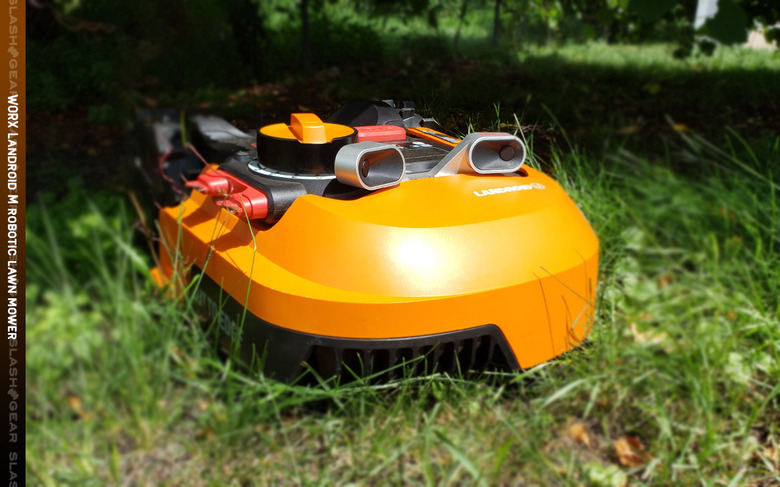
We've also been working with the Landroid Anti-Collision System which you'll see installed on the Landroid M above, looking like a pair of silver antenna eyes. We've also been working with the Landroid Garage for outdoor weather protection for the mower as it rests on its charging base. When you read this article, you might end up seeing the Landroid Garage (in this iteration) sold out, replaced by a slightly more advanced model with a friendly adjustable roof.
Setup and Software
To get this mower up and running, I needed to follow a few instructions. I needed to prepare my yard by placing a physical boundary around the space in which the mower would work, and I needed to prepare the mower and its base station for charging and storage.
• Open box, locate mower, Find My Landroid, Anti-Collision System, charging base, boundary wire kit.
• Locate Phillips head screwdriver and either a knife or a wire stripper tool (these are not included)
• Install Landroid app on smartphone.
• Install Find My Landroid GPS device.
• Install Anti-Collision System.
• Lay boundary wire around mowing area in yard.
• Locate replacement blades, extra boundary wire, stakes, place in a safe area for storage.
• Install charging base
• Install Landroid Garage
Laying the boundary wire around the yard, hammering in lawn stakes, and making sure the whole setup was properly staked down flat was probably the most difficult part of the entire setup process. The difficulty here was only really in the amount of actual WORK that was required – all that's really required is a significant amount of time unrolling, staking, and repeating.
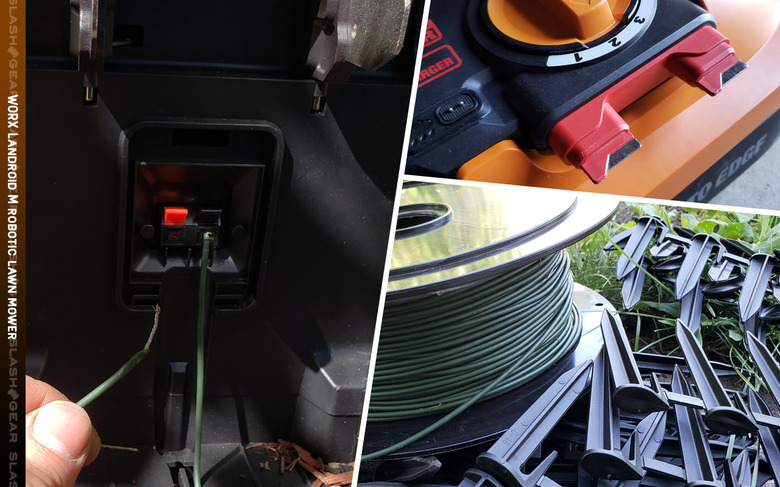
The wire connects to the charging base. If you've ever set up a stereo made in the 1980's or earlier, you've had to connect a wire like this before. You'll need either a knife or a wire stripper tool to pull back the rubber covering of the boundary wire to reveal the metal (aka the bare wire). One end of the wire is connected to the base with a spring clip, the wire runs around your whole yard and back (in a big square, rectangle, etc), where the other end of the wire connects to the base, creating a circuit.
If the wire is connected correctly, the charging base will light up with the color green. If at any point the boundary wire is cut or broken, at any point along the wire, the Landroid M mower will stop mowing your lawn and will immediately return to its charging base.
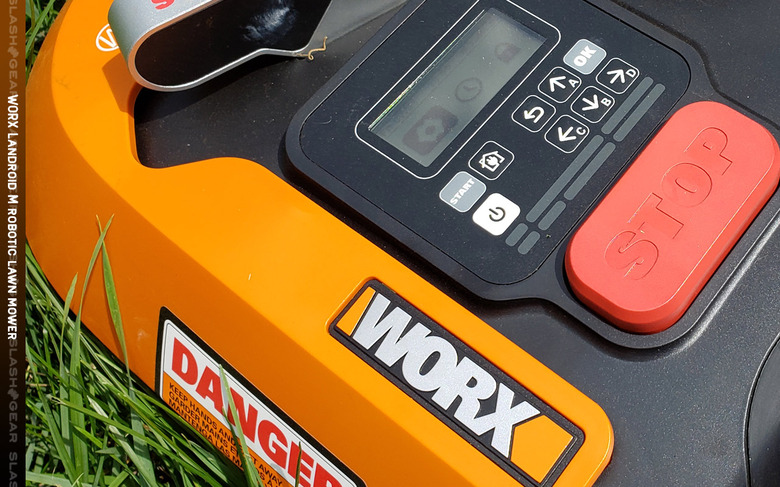
The mower detects the wire and will not move beyond the boundary created by the wire. If the boundary wire is cut, there's no more circuit. If the mower does not detect a boundary wire, it will refuse to mow.
BELOW: One of these photos shows a wire RIGHT next to a wall – that's not the correct way to do this. That part of the boundary was installed before I read the instructions close enough to realize that the wire needs to be a certain distance away from the edge of the grass.

One interesting item here I found out very early, the hard way: The boundary wire must be absolutely flat, and held down flat, to the ground. If the wire is loose on the ground and/or sits just a little bit above the ground, it can potentially be cut by blades of the Landroid M mower. This mower can cut its own boundary – BUT, if it does, it'll immediately head back to base, for safety.
If I'd installed the boundary wire correctly in the first place, this wouldn't have happened. Once I DID install the boundary wire correctly, I had no more issues.
Mowing in practice
You can set this mower up to mow on a timed schedule. You can set it to mow one day a week, or every day of the week. You can adjust this mower's blade base according to your lawn length desire, from 1.6- to 3.9-inches
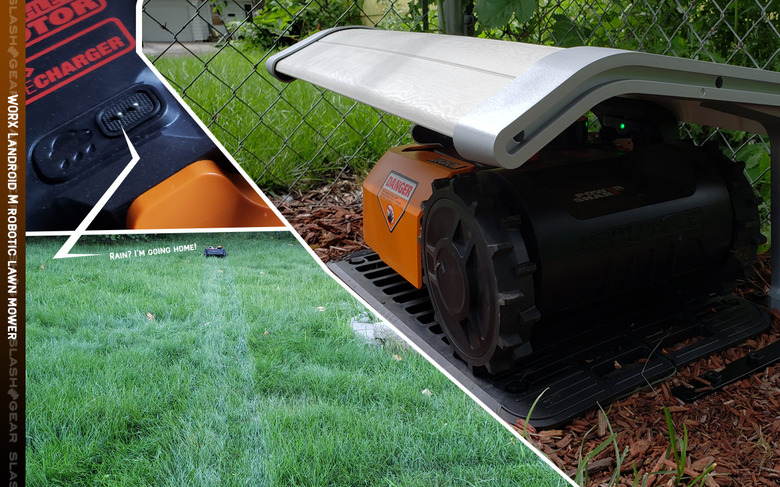
There's a water sensor on top of the mower so the unit will return to base if it detects rain. This robot can handily move through some rather intense grass – more intense than it's made to cut, really – but it's not prepared to take on deep holes. If you've got a particularly lumpy yard, this mower is not for you.
Mowing is right on-point if you're not allowing your grass to get completely insane between mows. When I started using the Landroid M, my grass was an absurd 6+ inches long, at least – this length of grass is not really compatible with this particular model. Instead, this mower's made for trimming, and keeping your lawn trimmed on a schedule.
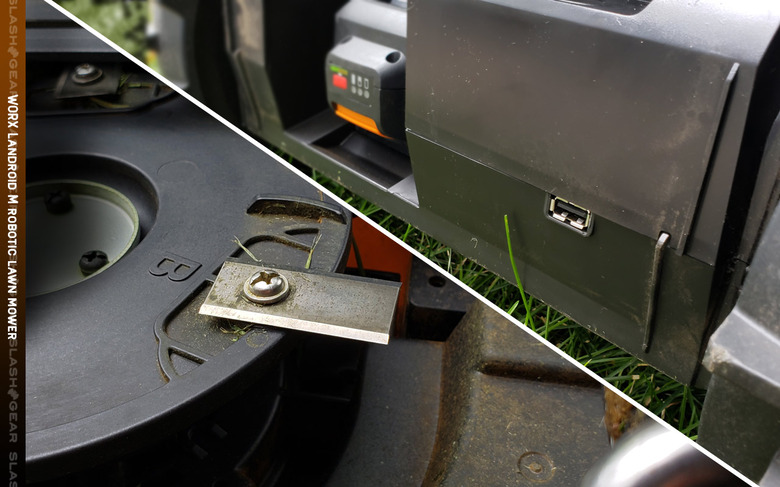
So once I got the lawn down to a reasonable length, I started running the mower on a schedule. Then I forgot it existed. One day I went to take the garbage to the garbage can and I noticed how nice my yard looked, and I wondered how it looked so clean, and even.
Then I remembered that I'd not cut the lawn in... a week? The Landroid M took care of the grass and made the process of cutting my lawn a complete non-issue. I'm at the point now that I'm not sure how I'll go back to not having an automatic lawn-cutter in my life. It's going to be tough to go back!
Wrap-up
The Landroid M 20V cordless robotic lawn mower with GPS will cost you approximately $1,199.96, with a three year warranty and a 30-day guarantee. At the time at which this review is set to go live, WORX has the mower on sale for $959.97 USD, which can be done in one lump sum, or in 4 payments of $239.99 USD.
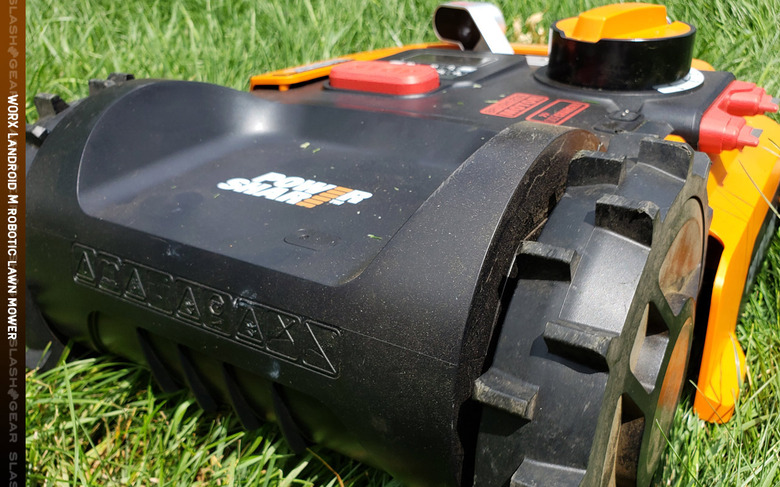
We've also been using the Landroid Garage, which will cost you around $130, depending on where you buy it. There's a slightly more advanced version of this protective hood available from WORX now for $150 (or around $120 if you're buying it around when this review goes live).
We've also got the Landroid Anti-Collision System installed. That's sold out on the WORX website when this review is set to go live, but it sells for around $250 USD on its own.
The price of this entire system is substantial. If you're ready to drop this kind of cash on a robotic lawn mower, chances are you're more concerned with the time it'll save you than the dollars and cents. In either case, the Landroid M works great, does what WORX claims it'll do, and it's relatively foolproof, especially once it's all set up for the first time.
